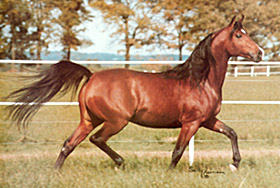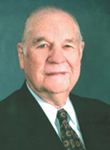 “I never thought I’d be old and poor at the same time,” Martha Ann Cassel confided to me, after the savings and loan debacle of the late 1980s forced her and husband Joe to liquidate their famed herd of Arabian horses.
“I never thought I’d be old and poor at the same time,” Martha Ann Cassel confided to me, after the savings and loan debacle of the late 1980s forced her and husband Joe to liquidate their famed herd of Arabian horses.
It wasn’t self-pity or dejection that prompted Martha Ann’s remark, rather an acknowledgement that a privileged upbringing hadn’t prepared her for the circumstances. Her inimitable spirit, however, was intact.
The Cassels radiated enthusiasm even in tough times. Just a call from Joe seemed to energize the phone.
 Until shortly before his death in 2005, at the age of 86, Joe Cassel was still promoting Arabian horses, along with the belief that athletic ability is the hallmark of a good horse. Cassel Casa Arabians, near Tyler in East Texas, was home to both race and show champions bred from foundation Polish stock. Joe wholeheartedly endorsed the Polish criteria for registering breeding stock based on athletic performance.
Until shortly before his death in 2005, at the age of 86, Joe Cassel was still promoting Arabian horses, along with the belief that athletic ability is the hallmark of a good horse. Cassel Casa Arabians, near Tyler in East Texas, was home to both race and show champions bred from foundation Polish stock. Joe wholeheartedly endorsed the Polish criteria for registering breeding stock based on athletic performance.
A native Texan and decorated WWII bomber pilot, Joe discovered purebred Arabians in the late 1940s, as a student at the University of Denver. There were fewer than 5,000 registered Arabians in the U.S. at the time, but Cassel remembered cowhorses, when he worked on ranches in the 1930s, that were reputed to a have “a little Arab blood” in them.
“I always wondered,” he said, “if just a little Arabian blood could make a difference, what a lot of it would do.”
Cassel found out on a visit to the Van Fleet Ranch near Boulder, CO, where L.W. Van Fleet, who admired Arabians for their grit and stamina, raised purebred Arabians to work his Herefords at an altitude of 8,600 feet.
In 1956, Cassel, by now a busy CPA, bought his first Arabian. But it wasn’t until 1970, when he and Martha Ann purchased a 275-acre farm in East Texas and named it Casa Cassel Arabians, that he began his linebred Polish program in earnest. The Cassel’s foundation sire, Brusally Zbruenu, by *Zbrucz, came from Ed Tweed, an early American importer of Polish and Russian Arabians. Later the Cassels acquired Roban by *Naborr, and Patriak by *Narin.
“Line breeding, not inbreeding, is practiced to produce consistency,” insisted Cassel, who based his program on the Polish stallions Comet, Priboj, Arax and *Salon, as well as the dam lines of Gazella II and Milordka. “In our opinion based on experience, the tail female lines are more important than the tail male lines.”
Some of the Cassel’s top performers included track record setter Cassels Bruszlem, sire of the first mare to be named racehorse of the year; Cassels Bruczest, 1981 IAHA Derby winner; Cassels Bruboj, who set two track records and placed in the IAHA Top Ten in 4 performance events, after being retired from racing; and Cassels Comet, the US National Champion Stock Horse.
Joe Cassel’s belief that beauty is inherent in a truly athletic Arabian was strikingly apparent at Casa Cassel. It was worth a trip to East Texas just to see Cassel mares and foals crest the ridge of the broodmare pasture at a run or to watch Joe put young colts through their paces (Joe had a lot of colts, but I never looked at one and thought it should have been a gelded, which is not the case at many farms).
In 2001, the Arabian Breeders Association presented Joe and Martha Ann Cassel with the ABA Lifetime Breeders Award in recognition of their achievements. Joe was inducted into the Texas Horse Racing Hall of Fame in 2002, the same year as Easy Jet, Bubba Cascio and Dr. Charles Graham.
The accompanying photo of Cassel’s Bruenu, by Brusally Zbrenua, taken by me in about 1987, was used for an ad that encapsulated Joe’s philosophy. In it he said: “Using blood from our breeding program to demonstrate the ability to produce beauty and athletic ability, Cassel’s Bruenu was created. He is what his pedigree says he should be – pretty and athletic and a carbon copy of his sire – but better.”
